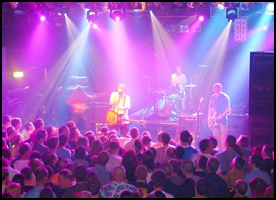
Both men had tried (and failed) in different punk outfits during their youth, and musical adventure was not therefore seen as a serious project, merely as a stop-gap. These sentiments didn’t change when Neil’s brother Simon, and his mate Paul, hooked up with them as lead guitarist and drummer respectively. They too were also involved in a punk band, called “Attempted Moustache”. Despite having no real intentions to make it big, they foursome decided to use the Vulcan Studios in Liverpool for practices, and became quite adept as a group. So much so, in fact, that they felt confident enough to send a demo around to all the local record labels to see their reactions. They expected nothing, which is precisely what they got from many, who politely declined their material. This was the case each time bar one; Probe, run by Geoff Davies who, under pressure from his wife, agreed to release the group’s work. During the course of the year, much work was done, many songs were recorded and the end product, “Back In The D.H.S.S.”, was released in 1985. The band’s skewed vision on life, portrayed in songs referring to football (especially their beloved Tranmere) and their life, and experiences of life in their area, won them respect and adoration among many in the indie circuit, although HMHB were not affected by fame and popularity, with them once refusing to miss a Rovers game to appear on a live music show on channel 4! Their first album was followed up in 1986 by the popular single and EP “The Trumpton Riots”.

HMHB Live At The Mean Fiddler
However in 1987, with their popular on an increase, HMHB announced that they were to split. As partial compensation, the fans were treated to a new LP, “Back again in the D.H.S.S”. That, however, was the last which was seen of HMHB for a while. Their inactivity was broken nearly four years later in 1990, and the original line-up continued where they had left off, releasing “McIntyre, Treadmore and Davitt”, a more polished effort than anything they had previously released. The album was a huge success, and live performances at the Reading festival among others followed.
After the success of their 1990 release, HMHB have never looked back. Album after album was released, each one portraying their unique musical qualities and sharp, witty commentary on life. The continuous roll of albums has coincided with changes in the band’s line up. In 1993, Paul and Dave left, with Carl Alty being drafted in as a replacement drummer. The band’s versatility was highlighted, with all the members having to be adept at more than one instrument. Ian Jackson became the new bass player and Neil became the guitarist. However these changes were undone in 1996, when Carl Alty joined Irish punk band Joyrider. Ken Hancock became the lead guitarist and Neil returned to his preferred role of bassist. Form then on, the band went from strength to strength. The band characteristically rejected a major recording deal in 1997, which was sandwiched in between two albums, “Eno Collaboration” in 1996 and “Voyage to the bottom of the Road” in the following year. The band’s rare gigs were well attended. The next year, the band released “Four lads who shook the Wirral”, and in 2000, they made another LP, called “Trouble over Bridgwater”. “Cammell Laird Social club” followed in 2002, and “Saucy haulage ballads” was released a year later. The band have maintained their original satirical attitude towards life and continue to churn out top quality music to this day...
Thanks to Will Clutton for writing this biography especially for this website.